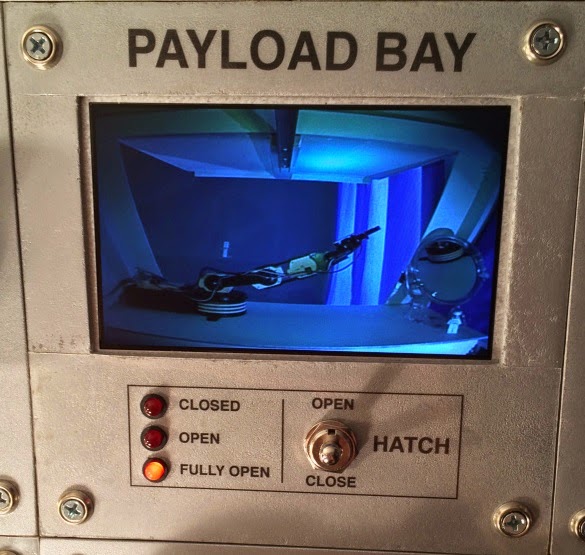 |
| Spaceship in bedroom |
The above video is featured in the June 26 "Making Fun: Kid’s Room Spacecraft" post on the Make magazine website. The Mission Control desk featured in the above video and Make post was highlighted in a February 19 Make post, "Making Fun: Mission Control Desk," and was explained in this video. If you liked the video and are interested in details of how Jeff built some of the parts, make sure to read the two posts linked above.
After watching that spaceship video, I was both inspired and embarrassed. Inspired by the awesome job Jeff Highsmith did of building the Mission Control desk for his sons, then later building a NASA spaceship that's linked to the Mission Control desk.
 |
| Control panel in spaceship |
As someone interested in learning about microcontrollers (MCUs) and about building things with MCUs, I was very much inspired by the variety of switches, lights, controls and realistic panels on the amazing desk and spaceship that Jeff built for his sons. As an engineer I was also inspired when he said in the video, "I put in an iPhone dock for future expansion. For now it will just play video from NASA, but in the future I plan to have some homemade satellites to monitor." I don't know if he meant homemade satellites that hang from the ceiling of his son's room, or if he is figuring that in a few years, there will be civilian satellites and he plans to have one or several of those civilian satellites be his. Either way I'm sure his expanded system will be cool, and his sons will have a great time with
 |
| Mission Control desk |
Now to the embarrassing aspect of the Highsmith Space Program. I'm a bit embarrassed I never made anything half as cool as that for my kids. I'm also a bit embarrassed that the Humboldt Microcontrollers Group hasn't come up with a really unique and interesting project that four or more people want to put a bunch of knowledge and skill into that will make people who see it say, "Whoa, that's really awesome!"
There are a couple things that I want to do a little differently as a result of watching Jeff Highsmith's videos and reading his Make magazine posts about the Mission Control desk and the spaceship.
 |
| Payload bay remote camera monitor |
The first thing to do differently with MCU projects is to 'think big while paying attention to details.' Jeff appears to have had a 'big picture' idea of what he wanted for his sons -- starting with a homework desk that can convert into a NASA Mission Control desk, then extending the space theme to his other son's bedroom with a spaceship. But what makes the desk and spaceship fantastic accomplishments is the close attention to the details. The control panels have complex and extremely realistic looking labels, switches, lights and controls. To make the experience authentic for his kids, Jeff incorporated recordings from NASA and simulations of actual astronaut problems. I realize the only way to tackle a large project is to break it down into small steps, but you have to have a good picture of what the large project will look like, and you have to pay attention to the small steps. When you know the big picture, and you're taking care of details, then commitment and perseverance have to kick in.
 |
| Mission status light panel |
The second thing to do differently on MCU projects is taking more photos and videos at each stage of a project, planning ahead of time the shots to capture for each project. Jeff's videos have excellent documentation of building the desk and spaceship. I became less embarrassed but no less inspired when I read that Jeff is a full-time videographer. That explains thinking things out enough ahead of time that he captured cool construction sequences while he was building the projects. It would be really good if the Humboldt MCU group could find a videographer or two who are interested in MCUs and electronics and would like to participate in the group's activities. They would know how to capture the story of a project, and they'd be able to put together a cohesive and impressive video.
 |
| Ardunio used to control instrument panel |
I think I'll keep a link to Jeff's spaceship video handy and watch that regularly to keep me inspired and to remind me of how rewarding completion of a big, complex project can be.
**********
No comments:
Post a Comment